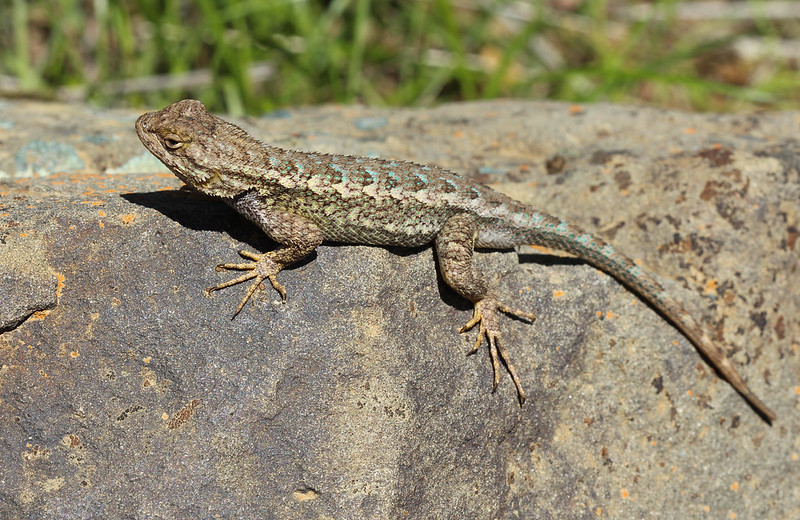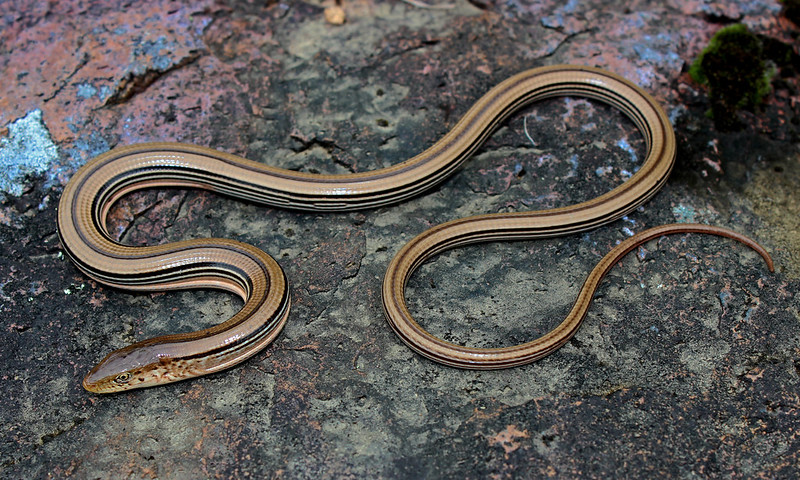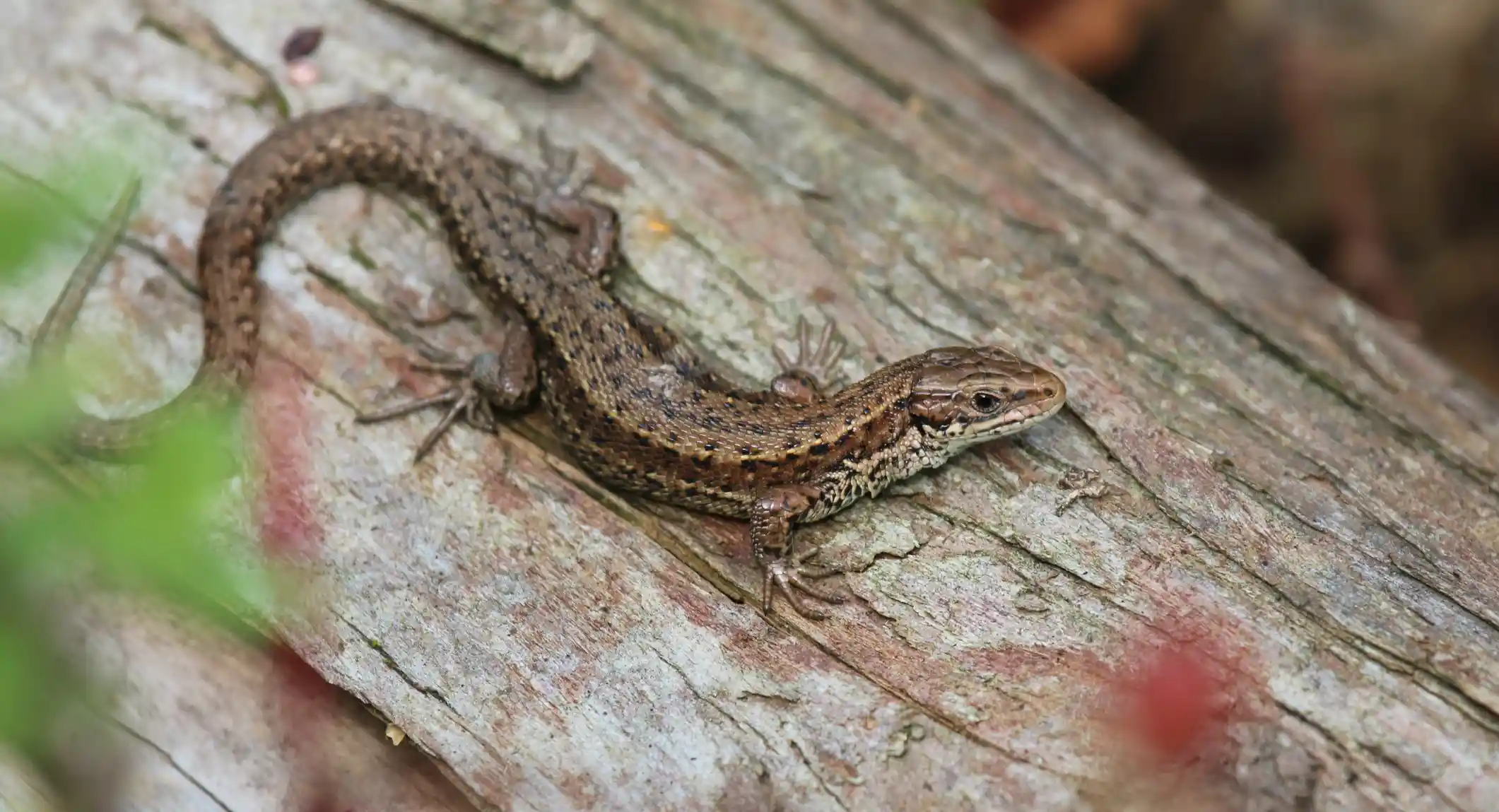When there are bushes and trees in the backyard, it is common to see some lizards sprinting before you sometimes. You probably wonder what do lizards eat in the backyard full of plants like that, I used to have the same question. So I want to bring you into a discussion about lizards in the backyard or garden today. We are going to talk about what they eat, their benefits, their nuisances, and how to get rid of them. It won’t be a long dialogue, so bear with me.
Contents
1. Common Backyard Lizards & Their Diets
Natural environment is the main thing that attracts animals of different sorts to live and hang out in. When you have a beautiful and peaceful backyard or garden, you will also often see lizards scooting around. The one thing that I can tell is that those backyard lizards are harmless and rather beneficial to the area. Below are 5 most common backyard lizards that you will come across from time to time.
1.1. Anole
Diet: Butterworm, crickets, wingless fruit flies, worms, and other insects

Green anoles are probably the most common lizards that you see in your garden or yard. These lizards are active, and they can also change their colors from bright green to dark brown when stressed. Many gardeners don’t mind having several green anoles running in their garden because they feed on insects. When not shooting across the backyard, anoles spend their time in higher places of at least 5 feet off the ground. These lizards can get very nervous when people or pets are near them. This is why they prefer to live high up in trees above the beings they perceive as threats.
1.2. Fence Lizard
Diet: Ants, beetles, grasshoppers, moths, spiders, stink bugs, and other invertebrates

Fence lizards may look a little scary because of their colorations and spiny appearance, but they are harmless. This type of lizard spends most of its day basking on fence posts, rocks, and trees then hides at night. The great thing about having them in the garden or yard is that they can help get rid of insects. From arthropods like beetles, centipedes, and spiders to gastropods like snails, these lizards eat them all. Sometimes they also feed on plant matter like cheatgrass and needle-grass if insects are not abundant. If you don’t mind lizards, it is nice to have some of them to naturally remove insects and pests.
1.3. Gecko
Diet: Bugs and insects

Many people don’t like geckos because of the noise that they make daily, especially at night. Little did they know that geckos are incredible pests controllers that help so much in the garden and yard. These lizards feed on annoying and dangerous insects like cockroaches, flies, moths, spiders, termites, and wasps. Even better, geckos don’t eat any fruits or vegetables in your garden at all. If there are a few geckos around, it is like you have professional pest controllers for free. Maybe they are pretty, but they are very useful for the gardens and yards. Having them around is way better than seeing the insects because geckos are not harmful.
1.4. Glass Lizard
Diet: Insects, spiders, and other small creatures

At a glance, you definitely take a glass lizard for a snake because this type of lizard is legless. Glass lizards are active during the day in open habitats, but they can quickly take refuge beneath boards and debris. This lizard species is native to North America, and they feed on any smaller bugs or insects that it can find. Glass lizards are non-aggressive and shy creatures, and they may allow a human to approach. At the same time, they don’t bite as they prefer to escape when they feel threatened. Glass lizards are also beneficial because they feed on beetles, crickets, rodents, spiders, and even snakes. You may relocate them if you don’t want the kids to be afraid, but keeping them is recommended.
1.5. Skink
Diet: Beetles, caterpillars, centipedes, crickets, flies, spiders, worms, and other insects

A lot of people don’t like skinks because they can be pretty invasive with where they choose to live. Besides the garden and yard, you may come across one in other places like basements, garages, patios, storage units, and more. Skinks nest in pairs, and their number can multiply in the area although they prefer to stay off each other’s territory. However, skinks are beneficial for gardens because they help eat insects all day every day for you. On top of that, they don’t damage plants or pose any threats to humans at all. This is also why many gardeners simply ignore them and just let them do their things. Because some skinks feed on small mice and rats, it is a total bonus to have them around.
2. FAQs:
2.1. What do blue belly lizards eat?
Blue belly lizards are insectivores, so they feed on bugs of all kinds that they can catch. As juveniles, blue belly lizards eat smaller insects like ants, baby crickets, and other bugs and insects available in the world. When they become adults, they go for larger prey like earthworms, grasshoppers, mealworms, spiders, waxworms, and more.
2.2. What do garden lizards eat?
Garden lizards are wonderful to have because they eat bugs and insects that harm your flowers and plants. Normally, garden lizards feed on common insects like ants, aphids, beetles, flies, grasshoppers, spiders, wasps, and worms. Some garden lizards may eat small berries and fruits to satisfy their diet, but they only need just a few. These lizards mostly depend on berries, fruits, and their prey for moisture, and they drink collected rainwater sometimes. That is not all, these natural pest controllers also feed on baby snakes or snake eggs if they find any. Just the thing that you need to keep your garden or yard safe from dangerous animals and harmful insects.
2.3. What do wild lizards eat?
Food is abundant in the wild, and wild lizards feed on pretty much anything that they can find. From leafy greens to insects, these four-legged reptilian creatures will eat them all. Also, different spices have different diets so that it is quite difficult to describe what they specifically eat. Simply put, there are 4 feeding groups in wild lizards including carnivores, herbivores, insectivores, and omnivores. Carnivorous lizards are larger types like Komodo dragons while herbivorous lizards are as rare as 3% of all lizards. As for the 2 latter types, they are the common garden and wild lizards that we often see.
2.4. Do lizards eat ants?
Yes, they do. Ants are part of a lizard’s diet although they prefer to go for larger insects around the house. However, you should not feed any types of ants to your pet leopard geckos. That is because ants could make them sick or even kill them. At the same time, leopard geckos must eat only live food, and live ants can bite or injure them. Apart from this species, lizards normally eat ants if they come across any.
2.5. What to feed a lizard?
Depending on what species your lizard is, fruits, vegetables, and insects are the common food to feed them. The most common food for herbivorous lizards are apples, blueberries, celery, lettuce, and strawberries in small pieces. As for insectivorous lizards, the best meal would be mealworms but you can also give them crickets and grasshoppers. Lizards are not picky eaters, all you need is the right food for their feeding characteristics.
3. How To Get Rid Of Lizards From The Backyard
I think one of the main problems that make people don’t like lizards is because there are too many of them. This is when they scatter around the areas to look for food, and probably cause damages to the plants. Many people also concern with the fact that some lizards can carry harmful bacteria like salmonella. They can transmit salmonella via their feces and urine which can cause serious illness upon contact. You can also get salmonella from the consumption of fruits or vegetables from the garden without a proper wash. So here are some tips on how to get rid of lizards or at least control their number in your backyard.
3.1. Cayenne Pepper
This is an easy and quick method that you can apply outdoor such as around the edges of the porch. All you have to do is sprinkle a little cayenne pepper in areas where lizards are frequent. You might also want to sprinkle it near the garden fences if there are many of them there. The strong scent from cayenne pepper is unpleasant to not only lizards but also critters like raccoons and other insects. Even better, cayenne pepper also irritates the feet of those animals which repels them from your property in no time. Most kitchens have cayenne pepper, and it is a useful spice to get rid of lizards fast also. To make it even more effective, re-apply it every few days outdoor so that they won’t come back.
[amazon_auto_links asin=”B00I9VAJKI”]
[amazon_auto_links asin=”B07CX526S8″]
[amazon_auto_links asin=”B07NQQ655G”]
3.2. Egg Shells
Natural and simple, egg shells are one of the things that you can use to prevent lizards from coming. Are lizards afraid of egg shells or something? The truth is that lizards, especially the herbivorous ones, dislike the smell that comes from eggs. This is why they will keep clear of any spaces with the smell of eggs. All you need to do is wipe the shells dry then leave them close to where lizards are frequent. You can also hang or put the empty egg shells on the top shelves to keep the lizards away. It is so easy and simple, and it does not leave any negative effects or odor that bother you at all.
3.3. Garlic & Onion
Similar to how the previous two work, garlic and onion are great combinations to repel lizards. The pungent smell will not only deter lizards from your home but also keep them away for good. In fact, garlic already works great but I want you to add onion to make the effects even better. This trick can get rid of lizards and many other insects and pests that dislike the strong smell coming from them. You can place a few garlic cloves and onion peels in places that lizards hang out. However, make sure that your pets are away from these two ingredients because garlic is poisonous to them. If this is the case, then I recommend you use it in a form of spray instead. Here is a quick guide on how to make your own natural lizard repellent.
3.4. Lemongrass
In this method, you can either use lemongrass or lemongrass essential oil because both work equally great. Another way is by lighting a candle with the scent of lemongrass, and its effects also last quite long. The key is to let the strong scent from the lemongrass spread around the areas to repel the lizards. When the smell that they don’t like keeps lingering, the lizards will pack their bags and move out. Many people also prefer this method because its presentation and smell are better than egg shells or garlic and onion.
[amazon_auto_links asin=”B07G2SJ871″]
[amazon_auto_links asin=”B07G2SJ871″]
3.5. Mothball
The smell from mothballs does not only deter lizards but also many other pests around and in the house. Mothballs are cheap and easy to find, and you can use them anywhere you like. Its strong effects affect bugs or insects with exoskeletons while its strong smell keeps critters like lizards away. So if you have some mothballs sitting somewhere in the house, it is time to take them out to use. Put a small amount of mothballs in a sachet or sprinkle them at the corners will do. Make sure that children and pets are away from the substance when you apply them because it can be dangerous. I recommend using this method in areas where your kids and pets don’t visit for safety.
[amazon_auto_links asin=”B01FG88MLE”]
[amazon_auto_links asin=”B01GK9S1GE”]
3.6. Naphthalene Balls
Not different from mothballs, naphthalene balls have the same effects that can get rid of lizards and pests. According to NPIC, naphthalene balls contain toxic gas that can kill insects and repel animals like lizards and other critters. They have a peculiar smell that many animals don’t like to be near, on top of the danger they pose. So if there are a lot of lizards that you want to get rid of, this is the method. It works both indoor and outdoor, and it also shows the results fast.
[amazon_auto_links asin=”B01CUP9W60″]
3.7. Pepper Spray
This is a good home remedy that you can easily mix by yourself to get rid of lizards from your home. The strong smell from the pepper spray simply discourages lizards from hanging out on your property. You will need a few ingredients including pepper, tabasco sauce, and water to mix in a spray bottle. Then feel free to spray this solution in the corners of the house and areas where lizards are common. Do not spray the mix directly on the lizards because it can harm or hurt them. At the same time, be careful when spraying because you also don’t want it to burn your eyes or skin.
3.8. Phenyl Tablets
You might think it is harmful to the lizards, but phenyl tablet is a non-toxic method to keep lizards at bay. What it does is that it has a smell that lizards don’t find appealing and pleasant to be near. So you can easily place phenyl tablets around the house and in different areas where lizards are common. I like the fact that these tablets make the bathrooms clean and leave the house with a good smell. Meanwhile, the lizards find the scent unpleasant to be around which is a big benefit. These tablets are also easy to find and use, and you really should give them a try.
4. Benefits Of Lizards in the Garden
Lizards don’t just live in your garden or yard rent-free, they also do some work too. Before you want to get rid of them, you might want to consider all the benefits that they offer. Some of the most helpful advantages that lizards provide are:
- Lizards help to keep insect populations under control.
- They feed on many pests like flies, gnats, slugs, spiders, and more.
- Lizards are harmless and nice, and they only attack their prey not humans.
- You won’t have to worry about pests eating your flowers or plants anymore.
- Some larger lizards also eat baby snakes or small snakes in the garden or yard.
Conclusion
Once again, lizards are beneficial animals to have in the garden and yard. These reptilian friends save us from using insecticides and pesticides while keeping control of other unwanted pests. Don’t feel bad if you see some of them at home because lizards only live in areas with good environments. Take that as a compliment and accept them because they don’t cause any harm to us at all. And if you don’t like having them around, make sure to get rid of those lizards in a safe way. The methods I recommend above are all easy and humane, feel free to use any of them.

